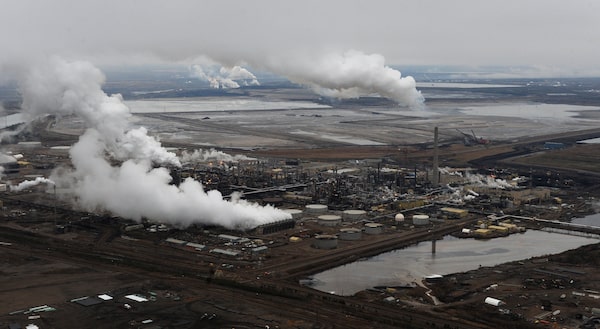
Aerial view of the Syncrude oil sands extraction facility with the Suncor extraction facility in the background, near the town of Fort McMurray, Alta.MARK RALSTON/Getty Images
The federal government has produced by far its most comprehensive roadmap to date for making good on Canada’s international commitments to reduce greenhouse-gas emissions.
In so doing, it has also laid bare the unprecedented degree of urgency and nimbleness that will be required – of the government itself, and of all the country’s major economic sectors – to have any real chance of reducing national emissions 40 per cent from 2005 levels by 2030, as promised.
Unveiled by Prime Minister Justin Trudeau and Environment Minister Steven Guilbeault on Tuesday at a climate conference in Vancouver, the Emissions Reduction Plan (ERP) – required by accountability legislation passed last year – got a mostly positive reaction from policy experts and advocates in attendance.
In particular, they considered it groundbreaking (for Canada at least) that the government has specified the emissions cuts needed from each specific sector over the course of this decade, rather than just working toward whole-of-economy targets.
That should now bring greater rhyme and reason to the government’s environmental policies and transparency in whether they are achieving their intended purpose, while giving industries fair warning of how much initiative they need to take if they want to avoid regulatory sticks being used against them.
But the plan is also full of very optimistic projections that would require extremely effective implementation of policies that are still only in development. And that’s made all the more daunting by the fact that the greatest ambition is also where there is the greatest potential for confrontation: around oil and gas production, responsible for more than a quarter of Canada’s total emissions.
After being one of the only sectors to have its emissions continue to rise over the past decade, the fossil-fuel industry will now be expected to cut them by 42 per cent (from 2019 levels, the most recent inventory) between now and the end of the decade.
Between Ottawa and the oil patch, a fragile sense of co-operation to reduce emissions
That’s supposed to happen without forcing production cuts. So it’s contingent on an eyebrow-raising contention, included in the ERP, that between 2026 and 2030, the carbon intensity of Canadian oil production will plummet below the global industrial average, despite now being far above it.
The only way that’s happening is through massive uptake of carbon-capture and other technologies being counted upon to make fossil-fuel production cleaner, despite oil and gas companies being slow to make those investments, even with soaring oil prices currently generating sky-high profits. So the government is effectively banking on its ability to suddenly get the industry to move at lightning-fast speed.
Not that it’s just oil and gas where the projections are at odds with current trajectories. Consider transportation, for instance.
On the surface, the projections for that sector – the second-largest emitter, combining with oil and gas to make up about half the national total – seem relatively modest, at about a 23-per-cent cut between 2019 and 2030. But that includes projections such as 20 per cent of all new passenger vehicle sales being electric by 2026 (before hitting 60 per cent by 2030), which is a very small window in which to exponentially grow that share from current levels. And likewise, 35 per cent of commercial truck sales being electric by 2030, despite very limited scale-up to date.
The leaps in some other areas are easier to fathom. Reducing emissions from electricity generation by a whopping 77 per cent from 2019 by 2030 is actually quite doable, given phaseouts of coal in the few provinces that still rely on it. If anything, a 32-per-cent reduction from heavy industry, such as steel and cement, may be a modest expectation given current technological advances plus carbon-capture potential. But there are others, such as reducing emissions from the heating of buildings by 42 per cent, where the plan identifies a big suite of as-yet undeveloped policies needed to make it real.
It’s tempting, in looking at how the government will try to meet all these expectations that it’s set, to focus on its wielding of public dollars. Even in a plan that makes no claim to being a full implementation document, there is about $9-billion in new allocations – much of it to recapitalize and expand existing programs, from supports for EV adoption to nature-based solutions. And that’s before a federal budget next week that will include other new subsidies, highlighted by a large new investment tax credit for carbon capture, geared primarily toward oil and gas.
But getting money out the door is the relatively easy part, at least in terms of expedience. Where the rubber will really meet the road, in terms of making the sectoral targets real, is in quickly introducing the sticks to go with the carrots.
That includes, most pivotally, regulated caps on oil and gas emissions that the government is currently in the early stages of developing. While the projections for that sector’s emissions cuts by 2030 give an indication of what the cap’s numbers will look like, there is an enormous amount of work to be done in figuring out how exactly they’ll be imposed – how punitive the mechanism will be, whether it will be administered on a facility-by-facility basis or sector-wide, and so on.
There is similar heavy lifting to be done on regulations that are supposed to reduce oil and gas methane leaks by 75 per cent. Likewise, the development of quotas for EV sales, known as zero-emissions vehicle mandates. And along with other sector-specific regulations, there is the whole matter of increasing the stringency of industrial carbon pricing, which involves continuing intergovernmental negotiations since most provinces have equivalency agreements to impose their own versions.
Canada considers tougher GHG rules for shipping in proposal at international meeting
On the regulations, there will be heavy pushback. Sometimes, as with the fossil-fuel industry on the emissions caps, it will mostly be a nuanced attempt to water down the regulations, without publicly disagreeing with the premise. In others, like the EV quotas, it will be more overt – as evidenced by the auto sector publicly criticizing the ERP’s hints of where those could land. In all cases, it could bog the government down in years of consultations and tweaks.
The plan presented on Tuesday, in fact, included a reminder of the danger there. It came in the form of a mention of continuing to consult on the low-carbon fuel standard. That policy is supposed to reduce the carbon intensity of fuels consumed in Canada, but has become something of a running joke in climate-policy circles, because of how many years it has spent in development, while being weakened along the way.
There is no time for that kind of endless process any more. Somehow, Ottawa will need to usher through many regulations at once, in less time than it sometimes requires just to massage a single one, to make the plan’s numbers real.
That means it can’t try to keep everyone happy, or to aim for perfection – either on the regulations, or on the broader sectoral strategies into which spending will also fit.
Even those generally singing the plan’s praises on Tuesday emphasized that it will require Ottawa to move away from business as usual in implementation – to still listen closely to industries, but to also be willing to pull the trigger on policies and adjust along the way.
“It means consulting enough to get a sound understanding of what needs to be done,” was how it was summarized by Dan Wicklum, who co-chairs the government-appointed Net-Zero Advisory Body. “And then having the courage to do that.”
Your time is valuable. Have the Top Business Headlines newsletter conveniently delivered to your inbox in the morning or evening. Sign up today.
 Adam Radwanski
Adam Radwanski